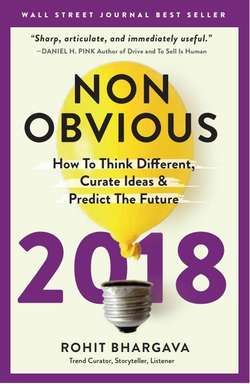Читать книгу Non-Obvious 2018 Edition - Рохит Бхаргава - Страница 18
Myth # 5 - Trends Are Hopelessly Broad Predictions
ОглавлениеPerhaps no other myth about trends is as fueled by reality as this one. The fact is, we encounter hopelessly broad trend predictions in the media all the time. Therefore, the problem comes in concluding that trends should be broad and all encompassing. Good trends tend to be more of the opposite: They define something that’s concrete and distinct, without being limiting.
For example, someone once asked me after an event if I had considered the rise of 3D printing as a trend. I replied that I had not, but the “Makers Movement”—which was a well described trend that focused on the human desire to be a creator and make something (which 3D printing certainly enabled)—was a worthwhile trend. The point was, a trend is never a description of something that just exists—like 3D printing.
Instead, a trend must describe what people do or believe as a result. Once you know that the “Makers Movement” describes the human desire to make something, for example, you can think about how to offer that type of fulfillment to your customers in how they interact with you. IKEA has benefitted from this trend for years—because people often feel a disproportionate emotional connection to furniture they had to work to assemble themselves. Psychologist have dubbed this the “IKEA effect.”
Now that I’ve shared the most common myths about trend predictions, let’s consider why so many trend predictions involve self-indulgent guesswork or lazy thinking. What exactly makes them so useless?
To answer this question, let me tell you a little story.
